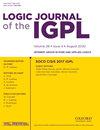从模态视角看建构主义理论
IF 0.8
4区 数学
Q2 LOGIC
引用次数: 0
摘要
我们提出了一类一阶直观论的哥德尔-麦金赛-塔尔斯基嵌入的统一证明论证。这是通过将证明分析的方法调整到模态逻辑的情况中来实现的,以便将公理转换成合适的序列微积分的推理规则。嵌入的健全性和忠实性是通过对增强计算中导数高度的归纳来证明的。最后,我们定义了一个模态系统的扩展,其结果在几何直观方面是成立的。本文章由计算机程序翻译,如有差异,请以英文原文为准。
Constructive theories through a modal lens
We present a uniform proof-theoretic proof of the Gödel–McKinsey–Tarski embedding for a class of first-order intuitionistic theories. This is achieved by adapting to the case of modal logic the methods of proof analysis in order to convert axioms into rules of inference of a suitable sequent calculus. The soundness and the faithfulness of the embedding are proved by induction on the height of the derivations in the augmented calculi. Finally, we define an extension of the modal system for which the result holds with respect to geometric intuitionistic.
求助全文
通过发布文献求助,成功后即可免费获取论文全文。
去求助
来源期刊
CiteScore
2.60
自引率
10.00%
发文量
76
审稿时长
6-12 weeks
期刊介绍:
Logic Journal of the IGPL publishes papers in all areas of pure and applied logic, including pure logical systems, proof theory, model theory, recursion theory, type theory, nonclassical logics, nonmonotonic logic, numerical and uncertainty reasoning, logic and AI, foundations of logic programming, logic and computation, logic and language, and logic engineering.
Logic Journal of the IGPL is published under licence from Professor Dov Gabbay as owner of the journal.

 求助内容:
求助内容: 应助结果提醒方式:
应助结果提醒方式:


